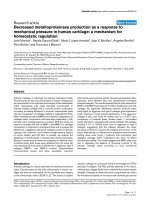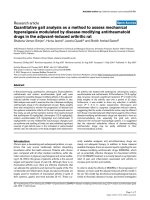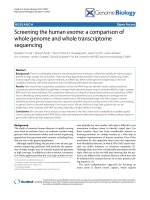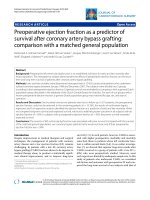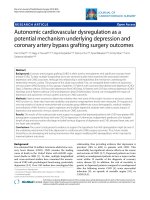Báo cáo y học: "Evaluating dosage compensation as a cause of duplicate gene retention in Paramecium tetraurelia" pot
Bạn đang xem bản rút gọn của tài liệu. Xem và tải ngay bản đầy đủ của tài liệu tại đây (101.51 KB, 4 trang )
Genome Biology 2007, 8:213
Minireview
Evaluating dosage compensation as a cause of duplicate gene
retention in Paramecium tetraurelia
Timothy Hughes*, Diana Ekman
†
, Himanshu Ardawatia*
‡
, Arne Elofsson
†
and David A Liberles
‡
Addresses: *Computational Biology Unit, Bergen Center for Computational Science, University of Bergen, 5020 Bergen, Norway.
†
Department of Biochemistry and Biophysics, Stockholm University, 10691 Stockholm, Sweden.
‡
Department of Molecular Biology,
University of Wyoming, Laramie, WY 82071, USA.
Correspondence: David A Liberles. Email:
Abstract
The high retention of duplicate genes in the genome of Paramecium tetraurelia has led to the
hypothesis that most of the retained genes have persisted because of constraints due to gene
dosage. This and other possible mechanisms are discussed in the light of expectations from
population genetics and systems biology.
Published: 22 May 2007
Genome Biology 2007, 8:213 (doi:10.1186/gb-2007-8-5-213)
The electronic version of this article is the complete one and can be
found online at />© 2007 BioMed Central Ltd
Many genomes display extensive gene duplication, which
may result from either small-scale duplications or from
duplication of the whole genome. What determines whether
both copies of a duplicate gene are retained in the genome,
and their subsequent evolutionary fate, is still a matter of
debate. Aury et al. [1] have recently characterized gene
duplication in the ciliate Paramecium tetraurelia, a uni-
cellular eukaryote, which appears to have undergone multiple
rounds of whole-genome duplication with a high level of
retention of the duplicate copies. They suggest that this high
level of retention is due to constraints arising from gene
dosage, rather than other proposed mechanisms. Here we
discuss these results in relation to the various models
proposed for gene duplication and retention.
When duplication of a gene, or genome, occurs in an
individual organism, it will only become part of the species
genome if it becomes ‘fixed’ in the population (that is,
becomes part of the genome of all members of the popula-
tion). If the initial duplication event is evolutionarily neutral,
the duplicated genes will become fixed in the population
with a probability dependent on the inverse of the effective
population size. It has been suggested, however, that the
initial duplication event is likely to be deleterious for gene
duplicates with functional regulatory regions, because of the
metabolic cost of producing extra protein [2]. This would
reduce the probability of fixation.
Given that fixation probably occurs much more quickly than
the resolution of the fates of the duplicate copies, most work
has considered fate determination as an independent step
that occurs after the random process of fixation. Once
fixation occurs, if there is purely neutral evolution at the
protein level, one copy of a duplicated gene will quickly
become a pseudogene, leaving a single ancestral copy with
an ancestral function. While relaxation of selective con-
straint is generally thought to occur after gene duplication,
negative selection, which discards changes, apparently
returns quickly. Negative selection on parts of the gene may
also be coupled to positive selection for the evolution of new
functions or levels of expression. Relaxation of selective
constraint (or a combination of negative and positive
selection) that quickly gives way to stronger negative
selection has been observed both in Paramecium [1] and in
computer simulations of the evolution of gene duplicates [3].
Models that aim to explain the retention of duplicated genes
include the subdivision of expression profiles or functions of
the ancestral gene between the duplicates (subfunctionaliza-
tion) [4]; the acquisition of new functions by one or both
duplicated copies (neofunctionalization) [5]; selection to
increase robustness by maintaining a highly conserved back-
up copy [6]; and selection for increased gene dosage or for
dosage-compensation effects, as suggested for Paramecium
(see also [7]).
Selection that depends on gene dosage can involve two
different mechanisms. Selection for increased gene dosage
involves a positive selection pressure to increase expression
from a locus that is already highly expressed and has little
mutational capacity to increase its expression or concen-
tration-dependent activity. The dosage-compensation model,
on the other hand, invokes a negative selection pressure to
retain the function and expression levels of both copies in
order to preserve the correct stoichiometry - the appropriate
amounts or activity of the proteins in relation to each other
or other proteins. Subfunctionalization is a nearly neutral
model, with neither positive nor negative selection on gene
function during the initial period of preservation, whereas
neofunctionalization involves positive selection for the
generation of new functions in the retained genes. Selection
for redundancy, like that for dosage compensation, is
characterized by negative selection. Several of these
processes can act at different levels of biological regulation:
for example, neofunctionalization and subfunctionalization
can occur through changes in protein expression, changes in
protein function, or changes in alternative or constitutive
splicing. Dosage compensation, on the other hand, is a
model in which conservation acts simultaneously on all of
these processes.
Genome duplication favors the retention of
duplicate genes
From examination of a variety of genomes, tandem and
segmental gene duplications are known to occur at very high
rates (on average 0.01 per gene per million years), similar in
magnitude to the rate of mutation per nucleotide site [8,9].
Following such duplications, the average half-life of a gene
copy is of the order of a few million years, with only a small
fraction of duplicates surviving beyond a few tens of millions
of years (TH and DAL, unpublished observations). Following
whole-genome duplication, on the other hand, a large
proportion of duplicate genes is retained after tens of
millions of years (as in Xenopus laevis [10]) or even hundreds
of millions of years (in teleost fish [11]). For teleost fish, the
rate of retention has been reported to be much higher for the
products of whole-genome duplication than for those of
small-scale duplication [11].
One possible explanation for these differences is that gene
fate is shaped by different evolutionary forces, depending on
whether a gene is duplicated in a whole-genome event or
not. In a whole-genome duplication, unlike a smaller-scale
duplication, the entire network of interacting partners is
duplicated together (Figure 1). It is unclear to what degree
this build-up of pleiotropic constraints is a limitation as
duplicates diverge, and this question needs to be addressed,
potentially using protein structural models. The dosage-
compensation model would predict that the build-up of
pleiotropic constraint is difficult to resolve without deleterious
effects, thus introducing a strong negative selection initially
against the loss of genes or interactions. This would lead to
gene retention and initial conservation of sequence and
expression after whole-genome duplication.
213.2 Genome Biology 2007, Volume 8, Issue 5, Article 213 Hughes et al. />Genome Biology 2007, 8:213
Figure 1
Possible outcomes for gene retention after whole-genome duplication. An
ancestral network of interacting proteins is shown. Following a whole-
genome duplication event, all of the proteins together with their
interactions are duplicated. Over time, depending upon the evolutionary
forces that are operating on the genome, different interactions are
retained, gained or lost. Under the dosage-compensation model (bottom
left), all interactions are retained. Under the subfunctionalization model
(bottom center), redundant interactions become nonredundant (blue).
When this is combined with the neofunctionalization model (bottom
right), new interactions are also gained (red). In this figure, all of the
duplicated copies have been retained as functional genes, but that is not
the most likely outcome with increasing evolutionary time.
Ancestral network
After WGD
After dosage
compensation
After
subfunctionalization
After
neofunctionalization
coupled to
subfunctionalization
Gene duplication in the Paramecium genome
With the sequencing of the genome of P. tetraurelia by Aury et
al. [1], it was found to contain 39,642 genes, more genes than
many other completely sequenced genomes. Furthermore,
these genes can be grouped into families whose members are
very closely related in sequence. Phylogenetic analysis of these
gene families points to a recent whole-genome duplication in
P. tetraurelia, in addition to several older genome duplica-
tions. The most recent duplication occurred long enough ago
for negative selection to have set in, however.
Aury et al. [1] find that duplicate genes for signaling proteins
and transcription factors are preferentially retained in the
genome, as are duplicated genes for proteins known to form
multicomponent complexes, with a positive correlation
between retention and the number of components in the
complex. A similar correlation between retention and
complexity was observed for genes involved in metabolic
pathways. More highly expressed genes were also more
likely to have been retained.
Interestingly, the co-retained duplicates did not always
originate from the same whole-genome duplication. In
regard to complex-forming proteins, genes that were co-
retained after the most recent whole-genome duplication
were not found to be those preferentially retained in the
older duplications. In all, Aury et al. [1] found that patterns
of retention across whole-genome duplications were affected
by gene function, and showed a preference for retention of
duplicated genes that had not retained a duplicate in an
older whole-genome duplication.
The authors conclude that dosage compensation to maintain
the stoichiometry of protein complexes and metabolic
pathways and keep them functioning correctly plays an
important part in the retention of duplicate genes after a
whole-genome duplication. From consideration of the traces
of the preceding whole-genome duplications they also propose
that over time there is a slow progressive loss of duplicates, as
gene-expression levels become adapted for stoichiometric
reasons, for example.
The dosage-compensation model predicts that duplicates of
genes for proteins that do not form complexes or do not have
concentration-dependent roles in metabolism will be rapidly
lost. In the case of duplicated genes encoding interacting
proteins, it predicts strong selection for retention, but if one of
the interacting duplicates is lost from the genome, the model
predicts that the loss of the remaining duplicate will now be
positively selected for. The first part of this prediction is
qualitatively satisfied by the observations from the P.
tetraurelia genome of the retention of genes for complex-
forming proteins. On the other hand, the retention patterns
and differing profiles of nonsynonymous (K
a
) and
synonymous (K
s
) substitutions (K
a
/K
s
profiles) for duplicates
of different ages do not seem to support dosage compensation
as the driving force for keeping them in the genome.
Selection as a result of dosage compensation thus appears to
be complex and may have a role in modulating other evo-
lutionary mechanisms. The apparent burst of either positive
selection or relaxation of selective constraint in the period
shortly after genome duplication implies that selective
mechanisms other than dosage compensation are also acting.
Following the most recent whole-genome duplication in
P. tetraurelia, species radiation occurred, resulting in the
P. tetraurelia complex of 15 sibling species. Aury et al. [1]
propose that this burst of speciation is a side-effect of the
whole-genome duplication, occurring as a result of differen-
tial gene loss in different populations, leading to inviable
hybrids and reproductive isolation by Dobzhansky-Muller
incompatibility [12]. Such a proposition is consistent with
the loss of proteins not under dosage-balance constraint
under the dosage-compensation model and in our opinion is
most consistent with speciation accompanied by neo-
functionalization or subfunctionalization.
In evaluating alternative explanations of the retention
profiles for duplicates in the paramecium genome, effective
population size may be an important consideration. Effective
population size (together with mutation rate) as a modulator
of the strength of selection has been implicated as an
important switch between subfunctionalization as a purely
neutral process and neofunctionalization or, potentially,
dosage compensation as mechanisms involving selection
[4,8,9]. Paramecium has been shown to have a relatively
large effective population size, making mechanisms that
involve selection possible [13]. However, it has been shown
that binding interactions as well as regulatory modules can
subfunctionalize in the preservation of duplicate genes
[3,14], and so the subfunctionalization model for gene dupli-
cate retention may also be consistent with a dependence on
the number of interacting protein partners, where the
probability of subfunctionalization might be expected to be
proportional to the number of ways of subfunctionalizing the
interactions with partners. This is a different mechanism of
gene retention from dosage compensation, but this charac-
teristic of subfunctionalization has not been evaluated to
show that it has the same potential to retain duplicate genes
in such high numbers as dosage compensation appears to be
able to do. Eventually, quantitative models characterizing
these various processes can be tested against the data to
extend our understanding of the process of gene retention.
Where does dosage compensation fit in?
Dosage compensation may indeed affect the short-term
retention rate of duplicate genes after whole-genome
duplication. Over longer time frames, however, proteins
involved in complexes and pathways are not preferentially
retained in the duplicate pairs originating from whole-
genome duplications, neither in P. tetraurelia, as indicated
Genome Biology 2007, Volume 8, Issue 5, Article 213 Hughes et al. 213.3
Genome Biology 2007, 8:213
by Aury et al. [1], nor in yeast [15] (except for ribosomal
proteins [16]). In fact, whereas 17% of highly connected
proteins (hubs) in the yeast protein-protein interaction
network belong to a pair originating from the relatively
ancient whole-genome duplication that has occurred in
Saccharomyces cerevisiae, only 5% of the party hubs, which
are coexpressed with their interaction partners, are part of
such a pair [15]. Homologous complexes in yeast appear to
have been created through stepwise partial duplications and
not through whole-genome duplication [17].
The results of Aury et al. [1] do suggest that after more
recent whole-genome duplication events, the duplicate
proteins belonging to complexes and pathways are initially
retained to a greater extent than other proteins. According to
this view, although dosage sensitivity is not sufficient for the
long-term fixation of duplicates in the genome, it may be
important in the first phase following the whole-genome
duplication. One might postulate dosage compensation as a
mechanism for holding duplicated genes in the genome for
some time, to give an opportunity for eventual neofunctiona-
lization (as has been suggested for subfunctionalization [3]).
However, even in the period immediately following duplica-
tion, stoichiometric issues will be dependent on the interplay
between expression and sequence as well as selective
pressures for concentration dictated by metabolism and
systems-level constraints. Further modeling work is needed
to understand the mechanism, as the suggestions by Aury et
al. [1] and alternative suggestions (such as subfunctiona-
lization of binding interactions) are part of an ongoing
synthesis to understand the process of gene duplication and
its relationship to the evolution of gene function.
Considering the case of metabolic networks, the patterns of
retention or modification have been observed to be
influenced by network structure, topology and function, and
the positioning of duplicate genes at key points in the
network. Genes coding for enzymes involved in directing
higher metabolic fluxes are subject to greater evolutionary
constraints as a gene duplication event would increase the
flux through an enzyme-catalyzed reaction. It has been
observed in S. cerevisiae that genes encoding highly
connected enzymes in metabolic pathways have a higher
likelihood of maintaining duplicates [18]. Thus, duplication
of genes encoding enzymes carrying high metabolic fluxes
are more likely to be retained compared to genes encoding
enzymes carrying lower metabolic fluxes.
Enzymes in a pathway can evolve with different functional
requirements, which can lead to mismatches in the enzyme
activities upon duplication [19]. This means that upregulation
of individual enzymes can increase or decrease the flux
capacity of the pathway and by different amounts. Hence, if
only certain proteins increase the performance of the pathway,
the duplicates of the other proteins in the pathway will not
provide extra fitness to the organism. This also has
implications for the retention of duplicate copies based upon
an entire pathway being duplicated, indicating that the
negative selective pressure for retention of each duplicate in a
pathway would not be equally strong. Interestingly, it has been
argued that the neutral expectation for biological networks
involves a more complex network than that minimally
required for function, without necessarily invoking robustness
as a driving force for this non-minimal network [20].
The findings by Aury et al. [1] lend further support to the idea
that dosage compensation can play a role in the retention of
duplicated genes in a genome. Whole-genome duplication
events in additional lineages representing different time
points will enable a fuller testing of this and other hypotheses,
as well as their functional implications for systems biology.
References
1. Aury J-M, Jaillon O, Duret L, Noel B, Jubin C, Porcel BM, Ségurens B,
Daubin V, Anthouard V, Aiach N, et al.: Global trends of whole
genome duplications revealed by the ciliate Paramecium
tetraurelia. Nature 2006, 444:171-178.
2. Wagner A: Energy constraints on the evolution of gene
expression. Mol Biol Evol 2005, 22:1365-1374.
3. Rastogi S, Liberles DA: Subfunctionalization of duplicated
genes as a transition state to neofunctionalization. BMC Evol
Biol 2005, 5:28.
4. Force A, Lynch M, Pickett FB, Amores A, Yan YL, Postlethwait J:
Preservation of duplicate genes by complementary, degen-
erative mutations. Genetics 1999, 151:1531-1545.
5. Ohno S: Evolution by Gene Duplication. New York: Springer-Verlag,
1970.
6. Kuepfer L, Sauer U, Blank LM: Metabolic functions of duplicate
genes in Saccharomyces cerevisiae. Genome Res 2005, 15:1421-
1430.
7. Withers M, Wernisch L, dos Reis M: Archaeology and evolution
of transfer RNA genes in the Escherichia coli genome. RNA
2006, 12:933-942.
8. Lynch M, Conery JS: The evolutionary fate and consequences
of duplicate genes. Science 2000, 290:1151- 1155.
9. Lynch M, Conery JS: The origins of genome complexity. Science
2003, 302:1401-1404.
10. Hughes MK, Hughes AL: Evolution of duplicate genes in a
tetraploid animal, Xenopus laevis. Mol Biol Evol 1993, 10:1360-
1369.
11. Blomme T, Vandepoele K, de Bodt S, Simillion C, Maere S, van de
Peer Y: The gain and loss of genes during 600 million years of
vertebrate evolution. Genome Biol 2006, 7:R43.
12. Orr HA: Dobzhansky, Bateson, and the genetics of specia-
tion. Genetics 1996, 144:1331-1335.
13. Snoke MS, Berendonk TU, Barth D, Lynch M: Large global effec-
tive population sizes in Paramecium. Mol Biol Evol
2006, 23:
2474-2479.
14. Braun FN, Liberles DA: Retention of enzyme gene duplicates
by subfunctionalization. Int J Biol Macromol 2003, 33:19-22.
15. Ekman D, Light S, Bjorkman AK, Elofsson A: What properties
characterize the hub proteins of the protein-protein inter-
action network of Saccharomyces cerevisiae? Genome Biol 2006,
7:R45.
16. Papp B, Pal C, Hurst LD: Dosage sensitivity and the evolution
of gene families in yeast. Nature 2003, 424:194-197.
17. Pereira-Leal JB, Teichmann SA: Novel specificities emerge by
stepwise duplication of functional modules. Genome Res 2005,
15:552-559.
18. Vitkup D, Kharchenko P, Wagner A: Influence of metabolic
network structure and function on enzyme evolution.
Genome Biol 2006, 7:R39.
19. Salvador A, Savageau MA: Evolution of enzymes in a series is
driven by dissimilar functional demands. Proc Natl Acad Sci USA
2006, 103:2226-2231.
20. Soyer OS, Bonhoeffer S: Evolution of complexity in signaling
pathways. Proc Natl Acad Sci USA 2006, 103:16337-16342.
213.4 Genome Biology 2007, Volume 8, Issue 5, Article 213 Hughes et al. />Genome Biology 2007, 8:213


